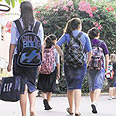
Ministry: Sex segregation from 4th grade
After avoiding disputed matter for years, Education Ministry issues regulations in regards to separation between boys and girls in state-religious schools
The Administration said, however, that schools were free to start gender segregation from as early as the first grade, or – alternatively – mix boys and girls in higher grades too, as long as the decision is made by at least two-thirds of the pupils' parents.
The Religious Zionism movement has been divided over the issue in recent years, as the conservative factions are in favor of starting segregation in the lower grades, while the more liberal factions support mixed education.
The ideological differences have turned into a real struggle in areas where one institution serves both populations, in many cases prompting segregation supporters to leave the state education system and establish private schools.
The Education Ministry has so far avoided making a decision on the matter, but has now issued a uniform policy formed by the State-Religious Education Council, which advises the Religious Education Administration. The new policy was approved by the Administration's chairman, Dr. Avraham Lifshitz, but still requires finalization through legislation and regulations.
'Issue stirring up emotions'
In its introduction comments, the State-Religious Education Council notes that the issue discussed "always stirs up emotions," and that therefore since the establishment of the state-religious education system in 1953, its leaders have refrained from coming up with a proper doctrine on the matter.
The situation created, however, is "improper both socially and ethically," the Council says, calling for a finalization and update of "anything missing and required in this field."
In the document, the Council reviews the history of gender segregation, noting that the first state-religious educational institutions in the early 20th century were all segregated, until "boys' schools and girls' schools became the trademark of Zionist-religious education."
From a halachic point of view, the Council ruled, "there was no rabbinical authority that approved permanent studies in mixed classrooms," and any such agreement stemmed from financial and other constraints only.
In the previous school year, there was full segregation in 200 schools, partial segregation in 50 schools, and mixed classrooms in 150 schools.
The recent years, however, have seen each side strengthen its ideology, and so "just like the trend of gender segregation of all ages grows stronger among many groups, a reverse trend grows stronger among other groups," the Council says in its introduction remarks.
Tensions high
According to the document published by the State-Religious Education Council, the result is heightened tensions between the two streams, which go as far as "arm wrestling" between parents in the same institutions, or the establishment of private schools, which – according to the Council – "do not carry the burden of public education despite the fact that most of their budget comes from public funding."
Moreover, there are those who insist on segregation even when the number of students in each classroom is small and there are not enough teaching positions and budgets on behalf of the State, so that the economic burden falls on the parents and the teachers' employment conditions are poorer than in the state education system.
"In such non-normative classrooms, principals are forced to shift hours from one assignment to another, maneuver between teachers and hours, and mainly rely on external financial sources," the Council says. "The principals are forced to operate on the edge – legally, administratively and financially.
"Non-normative classrooms create an inappropriate and unjustified budgetary burden on parents. The parents are required to pay for additional hours and teachers' compensation as part of a 'parents basket,' 'parents fund,' and other kinds of creative solutions."
Despite the need to regulate the issue, the Council stresses that it won't be performed through "instructions from above," as the state-religious education system "encourages discourse and a dialogue between the school and the population of parents and teachers, and matching the school's character and activity to the nature of the community it serves."
For this reason, separating between boys and girls from the fourth grade is seen as a default option and can be changed through a majority of 67% of the parents.
'Desire for social segregation'
The Ne'emanei Torah Va'Avodah religious Zionist movement, which has been fighting to reduce segregation for years, said in response to the Education Ministry's intervention: "We welcome any solution aimed at increasing peace in the communities and regulating the separation which exists in many cases due to the desire for social segregation.
"Religious Zionism's big challenge will be to restore the facts set on the ground back to a decent and proper situation from a social, religious and educational aspect."
The movement argued, however, that the document's instructions were too general.
"The main question is how things will be implemented on the ground. We must ensure that they work in favor of all parties, financially and administratively, rather than in favor of just one party.
"We believe that the halachic assumption encouraging segregation, which the document implies to, stems from perceptions that do not match halachic and ideological stances which exist at this time."










